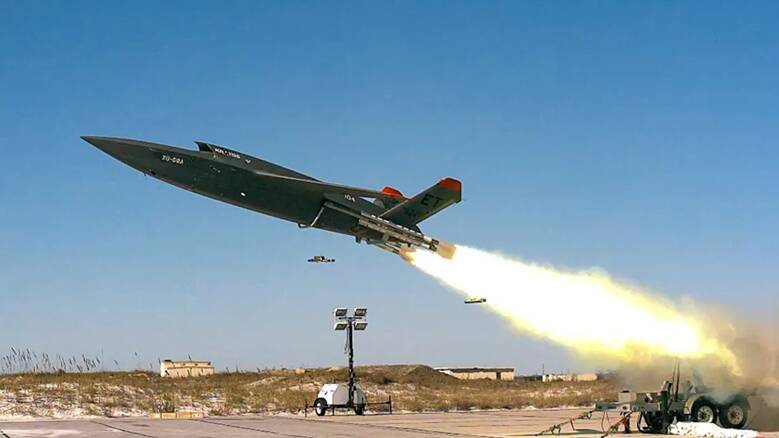
The US Air Force wants to spend around $5.8 billion on up to 2,000 pilotless AI-powered drones, to serve alongside human pilots.
Earlier this month, colonel Tucker Hamilton, chief of the Department of Air Force’s AI Test and Operations accelerator, reported that the aerial arm of the US military flew the 30-foot-long (9.15 metre) XQ-58A Valkyrie drone for three hours in a first-of-its-kind AI-controlled flight test.
Now, the Air Force believes it can build up to 2,000 Valkyrie aircraft, each one costing around $3 million – well below the price of crewed fighter jets like the F-35 or F-22.
Congress must approve the five-year effort to construct the drone fleet, which is budgeted [PDF] to cost $5.8 billion over that period – with $3.03 billion required in FY 2028 alone.
The Air Force describes the project as working towards development of “Collaborative Combat Aircraft … capable of enhancing crewed weapon systems to achieve air superiority.”
The Air Force envisions multiple types of AI-powered Valkyrie drones tailored to perform roles like surveillance or resupply operations, or swarming as a group to fight alongside human pilots. Drones designed for different roles will be kitted out with appropriate mission-specific hardware.
In collaboration with Kratos Defense & Security Solutions, a private military contractor company based in San Diego, the Air Force has been developing uncrewed XQ-58A Valkyrie aircraft for years.
“Any Air Force drone [will be] designed to allow commanders and operators to exercise appropriate levels of human judgment over the use of force,” a Pentagon spokeswoman told the New York Times.
Major general Scott Jobe, the Air Force’s director of plans, programs, and requirements, Headquarters Air Combat Command, reportedly previously said: “I’m not going to have this robot go out and just start shooting at things … think of it as just an extension to your weapons bay if you’re in an F-22, F-35 or whatnot.”
The crewless aircraft will therefore recommend actions that will be signed off by human operators, who make the final call to drop bombs or fire missiles.
That arrangement will reportedly be tested later this year in a mission that assesses Valkyrie’s ability to chase and wipe out an enemy target in a simulated scenario over the Gulf of Mexico. The experiment will also push the aircraft’s AI flight software into a dogfighting scenario. No weapons will be carried.
The Air Force is looking to contract with private operators, like Kratos or Shield AI, to develop the software and hardware components separately.
It could take between five and ten years to build an AI drone capable of real air combat, officials estimated. ®
- SEO Powered Content & PR Distribution. Get Amplified Today.
- PlatoData.Network Vertical Generative Ai. Empower Yourself. Access Here.
- PlatoAiStream. Web3 Intelligence. Knowledge Amplified. Access Here.
- PlatoESG. Automotive / EVs, Carbon, CleanTech, Energy, Environment, Solar, Waste Management. Access Here.
- PlatoHealth. Biotech and Clinical Trials Intelligence. Access Here.
- ChartPrime. Elevate your Trading Game with ChartPrime. Access Here.
- BlockOffsets. Modernizing Environmental Offset Ownership. Access Here.
- Source: https://go.theregister.com/feed/www.theregister.com/2023/08/29/us_airforce_drones/
- :has
- :is
- :not
- $3
- $UP
- 000
- 15%
- 2028
- 7
- 8
- 9
- a
- ability
- accelerator
- Achieve
- actions
- AI
- AI-powered
- AIR
- Air Force
- aircraft
- allow
- alone
- alongside
- also
- an
- and
- any
- appropriate
- approve
- ARM
- around
- arrangement
- AS
- assesses
- At
- based
- Bay
- BE
- been
- believes
- below
- between
- Billion
- build
- by
- call
- CAN
- capable
- carried
- chase
- chief
- CO
- collaboration
- collaborative
- combat
- company
- components
- construct
- contract
- Contractor
- Cost
- could
- Defense
- Department
- designed
- develop
- developing
- Development
- Diego
- different
- Director
- Drone
- Drones
- Drop
- each
- effort
- enhancing
- envisions
- estimated
- Exercise
- experiment
- extension
- fight
- final
- Fire
- five
- FLEET
- flight
- For
- Force
- FY
- General
- Go
- going
- Group
- Hamilton
- Hardware
- Have
- Headquarters
- HOURS
- hq
- HTML
- HTTPS
- human
- i
- if
- in
- into
- IT
- Jets
- jpg
- just
- later
- levels
- like
- looking
- make
- Mexico
- Military
- million
- missiles
- Mission
- Month
- multiple
- must
- no
- of
- off
- officials
- on
- ONE
- Operations
- operators
- or
- out
- over
- pentagon
- Perform
- period
- plans
- plato
- Plato Data Intelligence
- PlatoData
- previously
- price
- private
- Programs
- project
- Push
- RE
- real
- recommend
- required
- Requirements
- robot
- roles
- s
- Said
- San
- San Diego
- scenario
- scott
- security
- serve
- Shield
- shooting
- signed
- Software
- Solutions
- spend
- start
- surveillance
- Systems
- tailored
- Take
- Target
- ten
- test
- tested
- that
- The
- therefore
- things
- think
- this
- this year
- three
- to
- towards
- types
- us
- US military
- use
- VALKYRIE
- wants
- Weapons
- WELL
- which
- WHO
- will
- wipe
- with
- working
- year
- years
- york
- You
- Your
- zephyrnet













